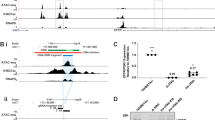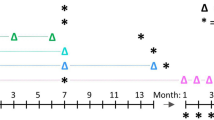Abstract
Although first generation recombinant adenoviruses, deleted of sequences spanning E1a and E1b, have been useful for in vivo applications of gene therapy, expression of the recombinant gene has been transient and often associated with the development of inflammation. We show that with first generation adenovirus–mediated gene transfer to the mouse lung, viral proteins are expressed leading to destructive cellular immune responses and repopulation of the lung with nontransgene containing cells. Second generation E1 deleted viruses further crippled by a temperature sensitive mutation in the E2a gene were associated with substantially longer recombinant gene expression and less inflammation. Stable expression of human CF transmembrane conductance regulator has been achieved in lungs of CF mice instilled with a second generation virus.
This is a preview of subscription content, access via your institution
Access options
Subscribe to this journal
Receive 12 print issues and online access
$209.00 per year
only $17.42 per issue
Buy this article
- Purchase on Springer Link
- Instant access to full article PDF
Prices may be subject to local taxes which are calculated during checkout
Similar content being viewed by others
References
Collins, F.S. Cystic fibrosis: molecular biology and therapeutic Implications. Science 256, 774–779 (1992).
Rosenfeld, M.A. et al. Adenovirus-mediated transfer of a recombinant α1-antitrypsin gene to the lung epithelium in vivo. Science 252, 431–434 (1991).
Rosenfeld, M.A. et al. In vivo transfer of the human cystic fibrosis transmembrane conductance regulator gene to the airway epithelium. Cell 68, 143–155 (1992).
Mastrangeli, A. et al. Diversity of airway epithelial cell targets for in vivo recombinant adenovirus-mediated gene transfer. J. clin. Invest. 91, 225–234 (1993).
Wilson, J.M. Vehicles for gene therapy. Nature 365, 691–692 (1993).
Engelhardt, J.F. et al. Direct gene transfer of human CFTR into human bronchial epithelia of xenografts with E1 deleted adenoviruses. Nature Genet. 4, 27–34 (1993).
Engelhardt, J.F. et al. Adenovirus-mediated transfer of the CFTR gene to lung of non-human primates: biological efficacy study. Human gene Therapy 4, 759–769 (1993).
Zabner, J. et al. Safety and efficacy of repetitive adenovirus-mediated transfer of CFTR cDNA to airway epithelia of primates and cotton rats. Nature Genet. 6, 75–83 (1994).
Simon, R.H. et al. Adenovirus-mediated transfer of the CFTR gene to lung of non-human primates: toxicity study. Human gene Therapy 4, 771–780 (1993).
Zabner, J. et al. Adenovirus-mediated genetransfertransiently corrects the chloride transport defect in nasal epithelia of patients with cystic fibrosis. Cell 75, 207–216 (1993).
Ginsberg, H.S. et al. A mouse model for investigating the molecular pathogenesis of adenovirus pneumonia. Proc. natn. Acad. Sci. U.S.A. 88, 1651–1655 (1991).
Prince, G.A. et al. Pathogenesis of adenovirus type 5 pneumonia in cotton rats. J. Virol. 67, 101–111 (1993).
Berencsi, K. et al. Pathogenicity of early region 3-replacement adenovirus recombinants in cotton rat and mouse lung. J. gen. Virol. (in the press).
Duncan, S.J. et al. Infection of mouse liver by human adenovirus type 5. J. gen. Virol. 40, 45–61 (1978).
Snouwaert, J.N. et al. An animal model for cystic fibrosis made by gene targeting. Science 257, 1083–1088 (1992).
Horwitz, M.S. Adenoviridae and their replication. In Virology (eds Knipe, D.M. et al.) 1679–1721 (Raven Press, New York, 1990).
Ginsberg, H.S., Horswood, R.L., Chanock, R.M. & Prince, G.A. Role of early genes in pathogenesis of adenovirus pneumonia. Proc. natn. Acad. Sci. U.S.A. 87, 6191–6195 (1990).
Engelhardt, J.F., Ye, X., Doranz, B. & Wilson, J.M. Ablation of E2a in recombinant adenoviruses improves transgene persistence and decreases immune response In mouse liver. Proc. natn. Acad. Sci. U.S.A. (in the press).
Müllbacher, A., Bellett, A.J.D. & Hla, R.T. The murine cellular immune response to adenovirus type 5. Immunol. Cell Biol. 67, 31–39 (1989).
Nevins, J.R. Mechanism of activation of early viral transcription by the adenovirus E1a gene product. Cell 26, 213–220 (1981).
Gaynor, R.B. & Berk, A.J. Cis-actlng induction of adenovirus transcription. Cell 33, 683–693 (1983).
Babbis, L.E. & Ginsberg, H.S. Adenovirus type 5 early region 1b gene product is required for efficient shutoff of host protein synthesis. J. Virol. 50, 202–212 (1984).
Imperiale, M.J., Kao, H-T., Feldman, L.T., Nevins, J.R. & Strickland, S. Common control of the heat shock gene and early adenovirus genes: evidence for a cellular E1a-like activity. Molec. Cell Biol. 4, 867–874 (1984).
Babiss, L.E., Ginsberg, H.S. & Darnell, Jr, J.E., E1b proteins are required for accumulation of late viral mRNA and for effects on cellular mRNA translation and transport. Molec. Cell biol. 5, 2552–2558 (1985).
Spergel, J.M. et al. NF-IL6, a member of the C/EBP family, regulates E1 a responsive promoters in absence of E1a. J. Virol. 66, 1021–1030 (1992).
Spergel, J.M. et al. NF-IL6, a member of the C/EBP family, regulates E1a-responsive promoters in the absence of E1a. J. Virol. 66, 1021–1030 (1992).
Brough, D.E., Droguett, G., Horwitz, M.S. & Klessig, D.F. Multiple functions of the adenovirus DMA-binding protein are required for efficient viral DMA synthesis. Virology 196, 269–281 (1993).
Yang, Y. et al. Cellular immunity to viral antigens limits E1-deletedadenovlruses for gene therapy. Proc. natn. Acad. Sci. U.S.A. 91, 4407–4411 (1994).
Smith, T.A.G. et al. Adenovirus mediated expression of therapeutic plasma levels of human factor IX in mice. Nature Genet. 5, 397–402 (1993).
Li, Q., Kay, M.A., Finegold, M., Stratford-Perricaudet, L.D. & Woo, S.L.C. Assessment of recombinant adenoviral vectors for hepatic gene therapy. Human gene Therapy 4, 403–409 (1993).
Logan, J. & Shenk, T. Adenovirus tripartite leader sequence enhances translation of mRNAs late afer infection. Proc. natn. Acad. Sci. U.S.A. 81, 3655–3659 (1984).
Ensinger, M.J. & Ginsberg, H.S. Selection and preliminary characterization of temperature-sensitive mutants of type 5 adenovirus. J. Virol. 10, 328–339 (1972).
Author information
Authors and Affiliations
Rights and permissions
About this article
Cite this article
Yang, Y., Nunes, F., Berencsi, K. et al. Inactivation of E2a in recombinant adenoviruses improves the prospect for gene therapy in cystic fibrosis. Nat Genet 7, 362–369 (1994). https://doi.org/10.1038/ng0794-362
Received:
Accepted:
Issue Date:
DOI: https://doi.org/10.1038/ng0794-362
This article is cited by
-
The efficacy of high-throughput sequencing and target enrichment on charred archaeobotanical remains
Scientific Reports (2016)
-
Combinatorial targeting of 2 different steps in adenoviral DNA replication by herpes simplex virus thymidine kinase and artificial microRNA expression for the inhibition of virus multiplication in the presence of ganciclovir
BMC Biotechnology (2013)
-
Generation of Cell Lines to Complement Adenovirus Vectors using Recombination-Mediated Cassette Exchange
BMC Biotechnology (2010)
-
Using viral vectors as gene transfer tools (Cell Biology and Toxicology Special Issue: ETCS-UK 1 day meeting on genetic manipulation of cells)
Cell Biology and Toxicology (2010)
-
Gene Therapy for Cystic Fibrosis
Clinical Reviews in Allergy & Immunology (2008)



